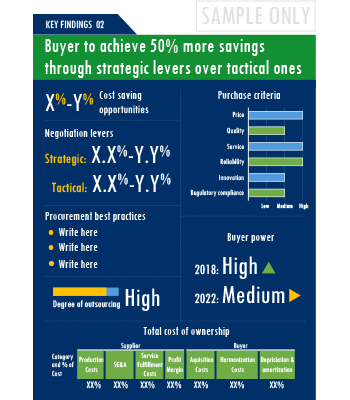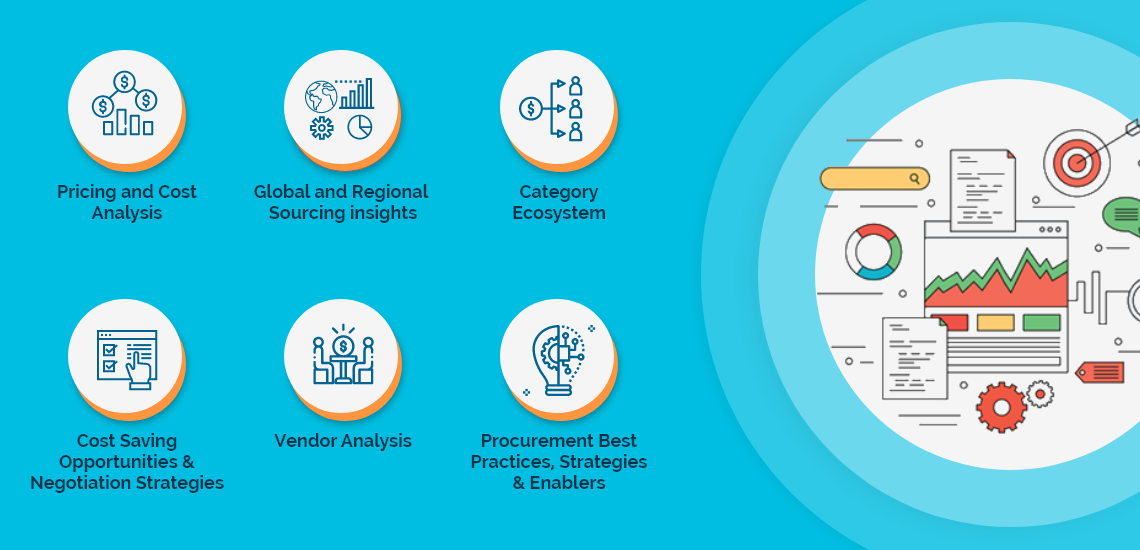A buying guide for Emergency Reporting Systems category – enriched with research on Emergency Reporting Systems procurement spend patterns, Emergency Reporting Systems pricing intelligence, market dynamics and top suppliers of Emergency Reporting Systems.
GET FREE SAMPLEThis report on global Emergency Reporting Systems category is part of a larger series of reports on global Security market. The scope of Security spans multiple categories and is typically identified as a procurement category that includes all spend related to securing premises, documents and storage facilities including all related goods and services.
The market for Security and its sub-segments such as Emergency Reporting Systems are at an interesting intersection. With advancement in technology, service providers are employing diverse tools in their operations to identify opportunities for optimization and greater collaboration with the customers.The category has historically lagged in tech adoption due to inadequate skillsets of majority of workforce and the perennial requirement to reduce facilities related cost. Therefore, suppliers who have demonstrated technological prowess to achieve efficiencies are being preferred over traditional vendors.As market presence of companies become global, there is a growing preference towards service providers who can provide services seamlessly across the globe and have excellent understanding of local regulations and culture.Trends like these and many others discussed in this report are necessitating a relook at the way Emergency Reporting Systems is procured and the procurement cost saving opportunities that exist.
As market conditions become more dynamic and procurement practices get more sophisticated, category managers need to be cognizant of the best practices that work for their Emergency Reporting Systems category procurement. The report offers a succinct analysis of Emergency Reporting Systems procurement best practices. For example, Buyers must clearly define clauses pertaining to the ownership of sub-contracting services that are not a part of their preferred suppliers' portfolios. This will ensure consistency in the services of sub-contracted firms as well as protection of confidential data. Buyers should evaluate the true costs of each product and service within the scope of work for supplier, and also understand the hidden costs associated. This can help them to set accurate targets for cost reduction for their suppliers, and effectively monitor and evaluate their performance against industry benchmarks. Buyers require industry-specific services to effectively operate their production facilities. Thus, they should opt for service providers that can offer customization and bring in years of experience in serving the needs of that industry.
Activate your free account to gain easy access to cutting edge research and insights on consumers, emerging price trends, global and regional suppliers.
Emergency Reporting Systems procurement managers also need to proactively identify and mitigate potential risks that can arise in the supply chain or contracts for Emergency Reporting Systems procurement. Some examples include:
For detailed insights and complete access to our report library, activate your free account!
The report is intended to serve as a one-stop reference guide for Emergency Reporting Systems procurement strategy and offers a perfect blend of category basics with deep-dive category data and insights. Therefore, it is ideal for category beginners looking for “Emergency Reporting Systems: Procurement Report 101” as well as for category experts actively tracking the global Emergency Reporting Systems procurement market.
You may have just initiated your research to design a winning Emergency Reporting Systems procurement strategy, or you may be a category expert looking for strategic insights and updated data.Either ways, the report has your requirements covered.

Unlock SpendEdge's comprehensive procurement report collection with ease through our procurement platform.
Procurement decisions can prove to be costly in the absence of careful deliberation and evaluation of every available option. In fact, more than 90% of the decision makers we work with acknowledge that timely availability of up-to-date category intelligence can help them make better purchasing decisions. More than 80% of them believe that in-house category intelligence needs to be updated periodically to achieve full benefits. If you have read so far, we are quite sure you agree!!
The Emergency Reporting Systems procurement report helps take more informed decisions by placing all the critical information and advice at the fingertips of a decision maker. It also specifically answers some of the key questions that we have been routinely asked during our industry outreach initiatives:
SpendEdge Insights has helped procurement professionals and sourcing teams manage multiple spend areas and achieve more than $2 billion in savings. Activate your free account today!
The Emergency Reporting Systems market report offers a complete picture of the supply market and analyzes the category from the perspective of both buyers and suppliers. Analysis of the category trends, procurement best practices, negotiation levers and overall category management strategy advisory are interspersed with in-depth data and commentary on spend outlook, pricing ecosystem and supplier landscape drilled down to a region-level coverage.

A key highlight of this report is the in-depth outlook created on Emergency Reporting Systems procurement spend and pricing trends. The report further delves deep into the aspects of cost structure, total cost of ownership and supplier margins for Emergency Reporting Systems. A dedicated section to supplier profiles and evaluation helps decision makers cast a wider procurement net and identify gaps in existing relationships.

Along with specific category and supplier intelligence, the publication also includes curated insights on Emergency Reporting Systems market trends, price influencers and inherent risks. These insights help the decision makers prepare for market shaping trends in advance and create alternative strategies for changes in the market conditions.

Additionally, the report also advises on the best practices and strategies to manage the Emergency Reporting Systems category efficiently. Negotiation levers and opportunities are explained in detail along with quantification of their potential. Benchmark KPIs for supplier and buyer performance management are also aggregated to better organize the category objectives. Other themes of advisory include ideal procurement organization structure, enablers to achieve KPIs or category objectives and ideal SLAs to have with suppliers.






Our research is complex, but our reports are easy to digest. Quantitative analysis and exhaustive commentary is placed in an easy to read format that gives you an in-depth knowledge on the category without spending hours to figure out “what does it mean for my company?”


SpendEdge presents a detailed picture of Emergency Reporting Systems procurement solutions by way of study, synthesis, and summation of data from multiple sources. The analysts have presented the various facets of the market with a particular focus on identifying the key category influencers. The data thus presented is comprehensive, reliable, and the result of extensive research, both primary and secondary.

Global Fire-Alarm Systems Market - Procurement Intelligence Report

Global Identification Equipment Market - Procurement Intelligence Report

Global Radar Detectors Market - Procurement Intelligence Report

Global Speed Limiters Market - Procurement Intelligence Report

Global Identification Badges Market - Procurement Intelligence Report

Global Buzzers Market - Procurement Intelligence Report

Global Fault Detectors Market - Procurement Intelligence Report

Global Baggage-Scanning Equipment Market - Procurement Intelligence Report

Global Biometric Sensors Market - Procurement Intelligence Report
Access this report and our entire procurement platform | Plans starting from USD 3000/ Year Buy Now
Copyright © 2024 Infiniti Research Limited. All Rights Reserved. Privacy Notice – Terms of Use – Sales and Subscription
Cookie Policy
The Site uses cookies to record users' preferences in relation to the functionality of accessibility. We, our Affiliates, and our Vendors may store and access cookies on a device, and process personal data including unique identifiers sent by a device, to personalise content, tailor, and report on advertising and to analyse our traffic. By clicking “I’m fine with this”, you are allowing the use of these cookies. You may change your settings based on a legitimate interest at any time, by selecting “Manage Settings” on our site. Please refer to the help guide of your browser for further information on cookies, including how to disable them. Review our Privacy & Cookie Notice.
